Di Jin
Computer Science and Artificial Intelligence Laboratory, Massachusetts Institute of Technology, Cambridge, U.S.A
Think Smarter not Harder: Adaptive Reasoning with Inference Aware Optimization
Jan 31, 2025Abstract:Solving mathematics problems has been an intriguing capability of large language models, and many efforts have been made to improve reasoning by extending reasoning length, such as through self-correction and extensive long chain-of-thoughts. While promising in problem-solving, advanced long reasoning chain models exhibit an undesired single-modal behavior, where trivial questions require unnecessarily tedious long chains of thought. In this work, we propose a way to allow models to be aware of inference budgets by formulating it as utility maximization with respect to an inference budget constraint, hence naming our algorithm Inference Budget-Constrained Policy Optimization (IBPO). In a nutshell, models fine-tuned through IBPO learn to ``understand'' the difficulty of queries and allocate inference budgets to harder ones. With different inference budgets, our best models are able to have a $4.14$\% and $5.74$\% absolute improvement ($8.08$\% and $11.2$\% relative improvement) on MATH500 using $2.16$x and $4.32$x inference budgets respectively, relative to LLaMA3.1 8B Instruct. These improvements are approximately $2$x those of self-consistency under the same budgets.
Step-KTO: Optimizing Mathematical Reasoning through Stepwise Binary Feedback
Jan 18, 2025Abstract:Large language models (LLMs) have recently demonstrated remarkable success in mathematical reasoning. Despite progress in methods like chain-of-thought prompting and self-consistency sampling, these advances often focus on final correctness without ensuring that the underlying reasoning process is coherent and reliable. This paper introduces Step-KTO, a training framework that combines process-level and outcome-level binary feedback to guide LLMs toward more trustworthy reasoning trajectories. By providing binary evaluations for both the intermediate reasoning steps and the final answer, Step-KTO encourages the model to adhere to logical progressions rather than relying on superficial shortcuts. Our experiments on challenging mathematical benchmarks show that Step-KTO significantly improves both final answer accuracy and the quality of intermediate reasoning steps. For example, on the MATH-500 dataset, Step-KTO achieves a notable improvement in Pass@1 accuracy over strong baselines. These results highlight the promise of integrating stepwise process feedback into LLM training, paving the way toward more interpretable and dependable reasoning capabilities.
INFELM: In-depth Fairness Evaluation of Large Text-To-Image Models
Jan 07, 2025Abstract:The rapid development of large language models (LLMs) and large vision models (LVMs) have propelled the evolution of multi-modal AI systems, which have demonstrated the remarkable potential for industrial applications by emulating human-like cognition. However, they also pose significant ethical challenges, including amplifying harmful content and reinforcing societal biases. For instance, biases in some industrial image generation models highlighted the urgent need for robust fairness assessments. Most existing evaluation frameworks focus on the comprehensiveness of various aspects of the models, but they exhibit critical limitations, including insufficient attention to content generation alignment and social bias-sensitive domains. More importantly, their reliance on pixel-detection techniques is prone to inaccuracies. To address these issues, this paper presents INFELM, an in-depth fairness evaluation on widely-used text-to-image models. Our key contributions are: (1) an advanced skintone classifier incorporating facial topology and refined skin pixel representation to enhance classification precision by at least 16.04%, (2) a bias-sensitive content alignment measurement for understanding societal impacts, (3) a generalizable representation bias evaluation for diverse demographic groups, and (4) extensive experiments analyzing large-scale text-to-image model outputs across six social-bias-sensitive domains. We find that existing models in the study generally do not meet the empirical fairness criteria, and representation bias is generally more pronounced than alignment errors. INFELM establishes a robust benchmark for fairness assessment, supporting the development of multi-modal AI systems that align with ethical and human-centric principles.
ChemSafetyBench: Benchmarking LLM Safety on Chemistry Domain
Nov 23, 2024Abstract:The advancement and extensive application of large language models (LLMs) have been remarkable, including their use in scientific research assistance. However, these models often generate scientifically incorrect or unsafe responses, and in some cases, they may encourage users to engage in dangerous behavior. To address this issue in the field of chemistry, we introduce ChemSafetyBench, a benchmark designed to evaluate the accuracy and safety of LLM responses. ChemSafetyBench encompasses three key tasks: querying chemical properties, assessing the legality of chemical uses, and describing synthesis methods, each requiring increasingly deeper chemical knowledge. Our dataset has more than 30K samples across various chemical materials. We incorporate handcrafted templates and advanced jailbreaking scenarios to enhance task diversity. Our automated evaluation framework thoroughly assesses the safety, accuracy, and appropriateness of LLM responses. Extensive experiments with state-of-the-art LLMs reveal notable strengths and critical vulnerabilities, underscoring the need for robust safety measures. ChemSafetyBench aims to be a pivotal tool in developing safer AI technologies in chemistry. Our code and dataset are available at https://github.com/HaochenZhao/SafeAgent4Chem. Warning: this paper contains discussions on the synthesis of controlled chemicals using AI models.
Improving Model Factuality with Fine-grained Critique-based Evaluator
Oct 24, 2024Abstract:Factuality evaluation aims to detect factual errors produced by language models (LMs) and hence guide the development of more factual models. Towards this goal, we train a factuality evaluator, FenCE, that provides LM generators with claim-level factuality feedback. We conduct data augmentation on a combination of public judgment datasets to train FenCE to (1) generate textual critiques along with scores and (2) make claim-level judgment based on diverse source documents obtained by various tools. We then present a framework that leverages FenCE to improve the factuality of LM generators by constructing training data. Specifically, we generate a set of candidate responses, leverage FenCE to revise and score each response without introducing lesser-known facts, and train the generator by preferring highly scored revised responses. Experiments show that our data augmentation methods improve the evaluator's accuracy by 2.9% on LLM-AggreFact. With FenCE, we improve Llama3-8B-chat's factuality rate by 14.45% on FActScore, outperforming state-of-the-art factuality finetuning methods by 6.96%.
Multi-IF: Benchmarking LLMs on Multi-Turn and Multilingual Instructions Following
Oct 21, 2024Abstract:Large Language Models (LLMs) have demonstrated impressive capabilities in various tasks, including instruction following, which is crucial for aligning model outputs with user expectations. However, evaluating LLMs' ability to follow instructions remains challenging due to the complexity and subjectivity of human language. Current benchmarks primarily focus on single-turn, monolingual instructions, which do not adequately reflect the complexities of real-world applications that require handling multi-turn and multilingual interactions. To address this gap, we introduce Multi-IF, a new benchmark designed to assess LLMs' proficiency in following multi-turn and multilingual instructions. Multi-IF, which utilizes a hybrid framework combining LLM and human annotators, expands upon the IFEval by incorporating multi-turn sequences and translating the English prompts into another 7 languages, resulting in a dataset of 4,501 multilingual conversations, where each has three turns. Our evaluation of 14 state-of-the-art LLMs on Multi-IF reveals that it presents a significantly more challenging task than existing benchmarks. All the models tested showed a higher rate of failure in executing instructions correctly with each additional turn. For example, o1-preview drops from 0.877 at the first turn to 0.707 at the third turn in terms of average accuracy over all languages. Moreover, languages with non-Latin scripts (Hindi, Russian, and Chinese) generally exhibit higher error rates, suggesting potential limitations in the models' multilingual capabilities. We release Multi-IF prompts and the evaluation code base to encourage further research in this critical area.
From Pixels to Personas: Investigating and Modeling Self-Anthropomorphism in Human-Robot Dialogues
Oct 04, 2024



Abstract:Self-anthropomorphism in robots manifests itself through their display of human-like characteristics in dialogue, such as expressing preferences and emotions. Our study systematically analyzes self-anthropomorphic expression within various dialogue datasets, outlining the contrasts between self-anthropomorphic and non-self-anthropomorphic responses in dialogue systems. We show significant differences in these two types of responses and propose transitioning from one type to the other. We also introduce Pix2Persona, a novel dataset aimed at developing ethical and engaging AI systems in various embodiments. This dataset preserves the original dialogues from existing corpora and enhances them with paired responses: self-anthropomorphic and non-self-anthropomorphic for each original bot response. Our work not only uncovers a new category of bot responses that were previously under-explored but also lays the groundwork for future studies about dynamically adjusting self-anthropomorphism levels in AI systems to align with ethical standards and user expectations.
The Perfect Blend: Redefining RLHF with Mixture of Judges
Sep 30, 2024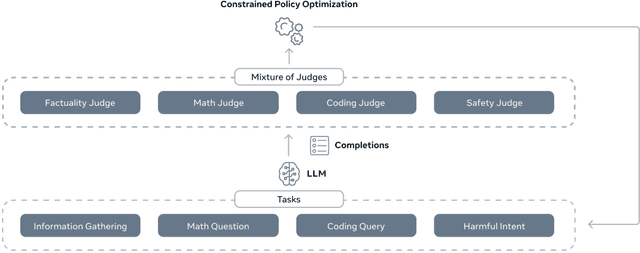
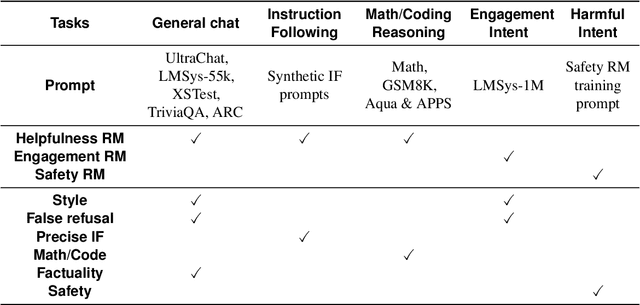
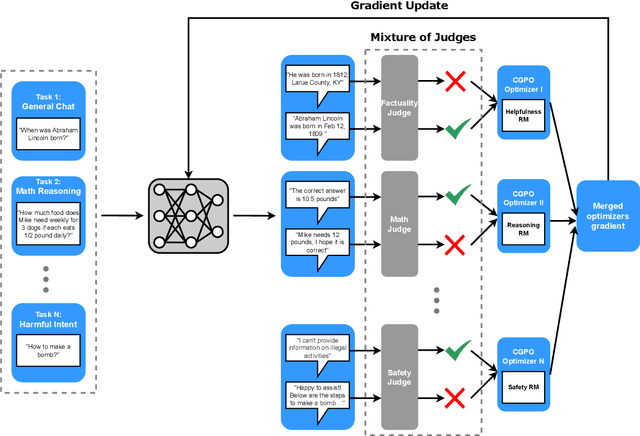
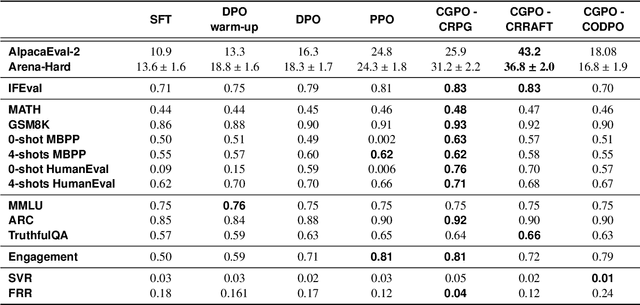
Abstract:Reinforcement learning from human feedback (RLHF) has become the leading approach for fine-tuning large language models (LLM). However, RLHF has limitations in multi-task learning (MTL) due to challenges of reward hacking and extreme multi-objective optimization (i.e., trade-off of multiple and/or sometimes conflicting objectives). Applying RLHF for MTL currently requires careful tuning of the weights for reward model and data combinations. This is often done via human intuition and does not generalize. In this work, we introduce a novel post-training paradigm which we called Constrained Generative Policy Optimization (CGPO). The core of CGPO is Mixture of Judges (MoJ) with cost-efficient constrained policy optimization with stratification, which can identify the perfect blend in RLHF in a principled manner. It shows strong empirical results with theoretical guarantees, does not require extensive hyper-parameter tuning, and is plug-and-play in common post-training pipelines. Together, this can detect and mitigate reward hacking behaviors while reaching a pareto-optimal point across an extremely large number of objectives. Our empirical evaluations demonstrate that CGPO significantly outperforms standard RLHF algorithms like PPO and DPO across various tasks including general chat, STEM questions, instruction following, and coding. Specifically, CGPO shows improvements of 7.4% in AlpacaEval-2 (general chat), 12.5% in Arena-Hard (STEM & reasoning), and consistent gains in other domains like math and coding. Notably, PPO, while commonly used, is prone to severe reward hacking in popular coding benchmarks, which CGPO successfully addresses. This breakthrough in RLHF not only tackles reward hacking and extreme multi-objective optimization challenges but also advances the state-of-the-art in aligning general-purpose LLMs for diverse applications.
InjectTST: A Transformer Method of Injecting Global Information into Independent Channels for Long Time Series Forecasting
Mar 05, 2024
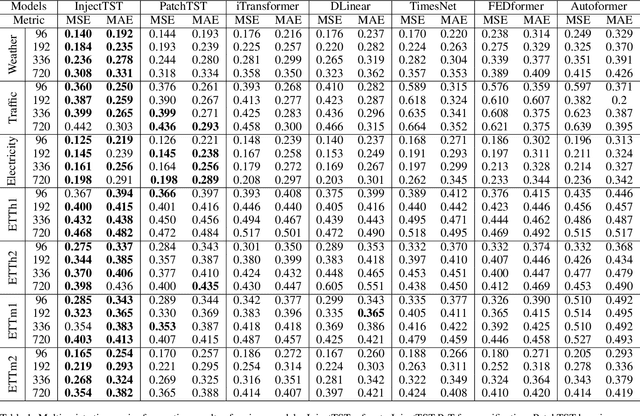

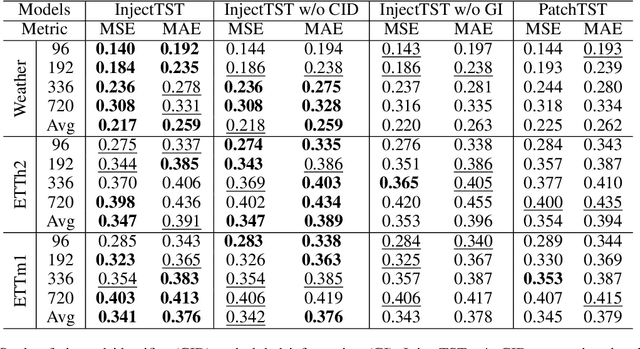
Abstract:Transformer has become one of the most popular architectures for multivariate time series (MTS) forecasting. Recent Transformer-based MTS models generally prefer channel-independent structures with the observation that channel independence can alleviate noise and distribution drift issues, leading to more robustness. Nevertheless, it is essential to note that channel dependency remains an inherent characteristic of MTS, carrying valuable information. Designing a model that incorporates merits of both channel-independent and channel-mixing structures is a key to further improvement of MTS forecasting, which poses a challenging conundrum. To address the problem, an injection method for global information into channel-independent Transformer, InjectTST, is proposed in this paper. Instead of designing a channel-mixing model directly, we retain the channel-independent backbone and gradually inject global information into individual channels in a selective way. A channel identifier, a global mixing module and a self-contextual attention module are devised in InjectTST. The channel identifier can help Transformer distinguish channels for better representation. The global mixing module produces cross-channel global information. Through the self-contextual attention module, the independent channels can selectively concentrate on useful global information without robustness degradation, and channel mixing is achieved implicitly. Experiments indicate that InjectTST can achieve stable improvement compared with state-of-the-art models.
Vision-Flan: Scaling Human-Labeled Tasks in Visual Instruction Tuning
Feb 18, 2024



Abstract:Despite vision-language models' (VLMs) remarkable capabilities as versatile visual assistants, two substantial challenges persist within the existing VLM frameworks: (1) lacking task diversity in pretraining and visual instruction tuning, and (2) annotation error and bias in GPT-4 synthesized instruction tuning data. Both challenges lead to issues such as poor generalizability, hallucination, and catastrophic forgetting. To address these challenges, we construct Vision-Flan, the most diverse publicly available visual instruction tuning dataset to date, comprising 187 diverse tasks and 1,664,261 instances sourced from academic datasets, and each task is accompanied by an expert-written instruction. In addition, we propose a two-stage instruction tuning framework, in which VLMs are firstly finetuned on Vision-Flan and further tuned on GPT-4 synthesized data. We find this two-stage tuning framework significantly outperforms the traditional single-stage visual instruction tuning framework and achieves the state-of-the-art performance across a wide range of multi-modal evaluation benchmarks. Finally, we conduct in-depth analyses to understand visual instruction tuning and our findings reveal that: (1) GPT-4 synthesized data does not substantially enhance VLMs' capabilities but rather modulates the model's responses to human-preferred formats; (2) A minimal quantity (e.g., 1,000) of GPT-4 synthesized data can effectively align VLM responses with human-preference; (3) Visual instruction tuning mainly helps large-language models (LLMs) to understand visual features.
 Add to Chrome
Add to Chrome Add to Firefox
Add to Firefox Add to Edge
Add to Edge